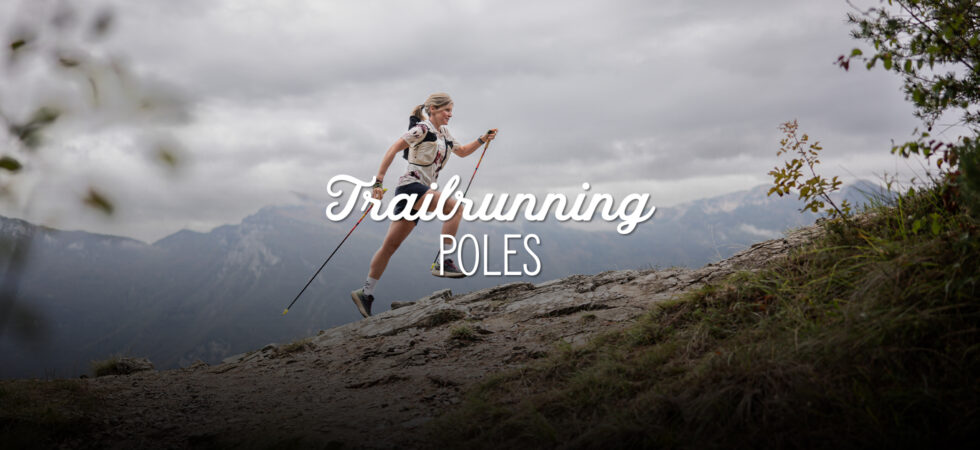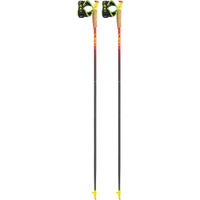As a trail runner, you spend most of your time in the mountains and alpine terrain. There, as well as when hiking, you like to have your poles with you. Used correctly, poles can be a great help and a relief in the mountains. Especially on steep climbs, but also on descents, good sure-footedness is required, which is supported by trail running poles. Poles can also provide an extra boost in competition or training.
Which poles are suitable?
Sport-Conrad also offers a wide range of poles for trail running. But which one is right for you? Trail running poles differ mainly in their construction, i.e. the way they can be shortened.

Telescopic poles
Telescopic poles have been around for a long time and are usually made up of two or three segments that can be pushed together, fixed and released from the outside by turning the pole elements or clamps. The advantages of this system are that it can be easily adjusted to suit both the user’s height and the terrain. However, in terms of weight and pack size, this design is not as good as folding poles. This design is more common in ski touring poles and walking poles. Most modern walking poles are therefore foldable.
Folding poles
Folding poles are a slightly newer concept and are particularly suitable for trail running. The pole sections are connected by an internal cord and can be unfolded at the push of a button. The system is similar to tent poles or avalanche probes and works very quickly and easily – even in competition conditions. The main advantages of this design are the very small pack size and low weight. Some models can be folded to a length of about 35 cm. This means that they will fit into even the most minimalist running rucksack when not needed on flat terrain. Poles of this type for use in competitions sometimes weigh no more than 130 grams per pole.
Of course, there are also poles that combine the best of both worlds. These hybrid poles have a folding system and an extra adjustment area at the top of the stick. They can be folded up quickly and easily and adjusted to suit the terrain. These all-rounders probably offer the best compromise between comfort and ease of use, especially over longer distances thanks to the length adjustment, and a relatively small pack size.
Fixed length
Finally, there are poles that are neither foldable nor adjustable. These poles undoubtedly offer maximum stability and power transmission. Their rigid construction makes them particularly popular for uphill or vertical races, where you are unlikely to let go of the pole and maximum uphill speed is essential.

Conclusion: Which poles should I choose?
As you may have noticed, your new poles should usually be a folding poles. They’re light, easy to pack and strong enough for hill running. For most competitive events up to the marathon distance, a folding pole will get you there. If you are looking for a pole for longer distances, such as an ultra trail or stage race, and you are also going to be running longer distances, it is worth considering folding poles with length adjustment. The advantage of this is that you will be more comfortable during strenuous stages at a moderate pace. If you are a mountain running fanatic and regularly run vertical races, you should have a fixed length pole without any further adjustment options, as this is where the lowest weight and maximum power transmission count.

What is the right pole length for me?
You can easily determine the length of your pole for trail running. There is a rule of thumb for calculating pole length: height x 0.7 = pole length. For a man who is 180 cm tall, this equates to a pole length of 126 cm. It’s a good idea to try a cane of the right length in the shop. Also, make sure you have a 90° angle between your upper arm and forearm when you place the pole perpendicular to the ground.
Hesitating between two pole lengths? Are you a beginner and new to poles? When in doubt, choose the next smaller pole length, this will make walking easier for you and help you learn the technique faster and easier.
Handle Systems
Pole handles can be made from a variety of materials. Plastic, EVA foam and cork grips are common. For trail running, however, EVA foam and cork have become the norm in the upper price range. By now you should have a few models in your hands to be able to judge the different grip shapes, materials, and feel. The most important thing is that the pole feels good in your hand and that the grip is intuitive.
Foam grips offer good slip resistance, protect against blisters and are very strong and durable. Cork grips are preferable in summer or for intensive use, as they reduce perspiration and provide a more comfortable grip.
Strap systems
You can choose between a normal wrist strap and a glove that can be removed from the pole and clicked onto the pole. For trail running, the click system is the most popular. The advantage of the click system is the direct connection between the hand and the pole, which greatly improves power transmission and precision when using the pole. It also eliminates the need to hold and guide the pole in your hand, making it much more comfortable to use over longer distances.

Trailrunning is your thing? We have more inspiration for you:
→ Trailrunning backpack and hip bag guide
→ Gap Pub Run: Garmisch-Partenkirchen’s Running Group
Pictures copyright: LEKI










